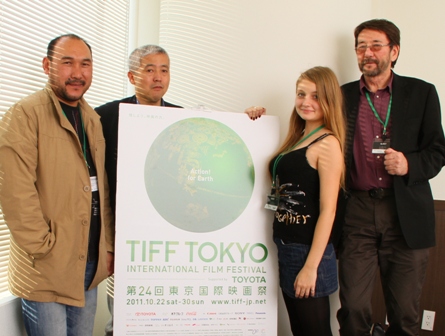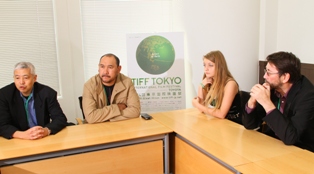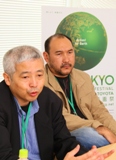Japanese Eyes “The First Rains of Spring”
interview with Shinju SANO (Director/Screenplay), Erlan NURMUHAMBETOV (Director/Screenplay), Murat NUGMANOV (Producer), Anastasiya BIRCHOVA (Actress)

To the left:Erlan NURMUHAMBETOV (Director/Screenplay), Shinju SANO (Director/Screenplay), Anastasiya BIRCHOVA (Actress), Murat NUGMANOV (Producer)
Though presented in the Japanese Eyes section of this year’s festival, “The First Rains of Spring” is very much a movie of Kazakhstan, since it takes place in Kazakhstan, has a mostly Kazakhstan cast, and considers themes that are rooted in Kazakhstan. The reason it is considered a Japanese film is that one of the two directors and screenwriters is Shinju Sano, a Japanese filmmaker who has lived and worked in Kazakhstan for several decades. During out discussion of the film, which also included the film’s co-director and lead actor, Erlan Nurmuhambetov, actress Anastasiya Bircthova and cinematographer-executive producer Murat Nugmanov, Sano not only acted as the Russian-Japanese interpreter, but also as pundit and commentator, filling out his answers to questions with discourses on related topics. For instance, when asked how he and Nurmuhambetov divided directing chores, he explained their shared history.

“When I was working at the Kazakhstan Embassy twenty years ago, Erlan was studying at the film school, whose director was a friend of mine,” Sano explained. “He said he wanted to show Yasujiro Ozu’s films at the school, and since I had once worked at Shochiku and Ozu was one of the reasons I began working in film I translated ‘Tokyo Story’ into Russian and showed his students the film.” He got to know some of the students, one of whom was Nurmuhambetov, and some years later they worked together on a film called “Yashi,” after Nurmuhambetov had worked as second director on Sergei Dvortsevoy’s “Tulpan,” which won the Sakura Grand Prix at the 21st TIFF. Nevertheless, Sano is rather clear that he “lead the direction” of “The First Rains of Spring.” “I have a very strong personality,” he added “and Erlan is a little less strong so we were able to balance each other.” After jokingly referring to the “dictator culture” of Russia and western Asia, Sano said, “Everybody wants to be the leader, so you need a strong personality to overcome that.”
Nurmuhambetov didn’t seem bothered by this assessment. “I know how to make films because of the various jobs I have done in the past,” he said, “but in terms of directing it was really an exchange of ideas. Film is a form of common language, so it has to be universal, everybody has to understand.”
Though the movie’s basic storyline has a certain universal appeal, its particulars are rooted in the local culture, and as both directors emphasized, a viewer can’t fully appreciate the movie’s message without understanding the role that nature has in the lives of the people depicted. The central family lives on an empty, vegetation-less plain at the base of a mountain range, where they raise various livestock. Their household includes an old Altaic woman named Dergelei who one evening informs the family that she will soon “join my ancestors” and that afterwards she will come back in a different form to marry their son, Askhat.
“Let me explain something about the old woman,” Sano says. “We don’t reveal her background in the film. She had been traveling for thousands of kilometers and she happened to come to this house when the mother was having a baby. She helped the family at that point and felt her destiny was with this family, and so decided to stay. When she knew her death was imminent she was worried about Askhat’s future.”
Though this idea of reincarnation and Askhat’s future is the main narrative theme, the movie interweaves three story threads. In one, the mother and father―the latter played with great humor by Nurmuhambetov―take the old woman’s body to a faraway place to burn her in accordance with Altaic custom. Along the way they encounter people in slightly comical situations–a border official who asks them to deliver a goat for him; a gas station attendant who only has jet fuel on hand–and reveal their own marital conflicts when their truck breaks down. The second thread is the daily lives of the three children left behind. The third thread involves a Russian father and his teenage daughter (Bircthova) taking a motorcycle trip through Kazakhstan. The father is estranged from his wife and the trip is presented as a means for the two to strengthen their familial bonds. In the end it’s implied that the daughter, Masha, becomes the receptacle for Dergelei’s soul.
“It didn’t really matter,” Sano said when asked if it was significant that Dergelei chose a Russian to carry out her prophecy. “Maybe she thought Masha was cute and would be the right girl for Askhat, and that he would probably like her as well.” Bercthova believed “it was simply fate.”
And while neither director thought it important to play up the Russian angle, they both insisted that Russians and Kazakhs coexist “without conflict” in present-day Kazakhstan, which was part of the Soviet Union before it broke up. “Kazakhstan wasn’t strongly influenced by Russian power,” Sano says. “But compared to the other republics, there is still quite a high percentage of Russians living there. Right after independence most of the people could only speak Russian, but now Kazakhs speak Kazakh, and those born in the 20 years since can hardly speak any Russian at all. But it’s not just Russians. As we show, there are also Altaics, who have their own language. Remember, the Silk Road passes through Kazakhstan, and there is something like 130 different cultures existing in the country, and there have never been any disputes or civil wars. It’s a very peaceful country.”

Nurmuhambetov admits that “Kazakhstan has its political issues,” one of which is that the same man has presided over the country ever since it gained independence. “But in terms of cultural differences and conflicts, they don’t really exist, at least not in the way they exist in other countries. And this is an ideal we wanted to show.”
In that regard, Sano may have been more of a force than Nurmuhambetov, who wrote the original 9-page script without any references to Altaics. As Sano explains it, “The story was more pastoral. There was a family, isolated, and for some reason the mother and father have to go away, leaving the children behind. Then some Russians appear and leave. Later, I wondered about these Russians, and wanted to make the Russian girl more of a central character because I had Anastasiya in mind to play her. How did she come to such a place? Why was she attracted to the people of Kazakhstan? I thought about all this at a coffee shop in Nihonbashi, Tokyo, where I live. I thought about Islam, but there are other religions, and then I thought about Altaics and their shamans. I ended up adding 90 pages.”

In the end viewers may be less interested in the cultural aspects of the film than in the visual ones. As with “Tulpan,” the vast empty landscapes put the characters in proper perspective. Whatever our individual situations, we are always at the mercy of nature. “I didn’t really think much about why these characters had to be there,” Nurmuhambetov says. “The point is that people are part of nature and so they have to live with it.”
Interviewed by Philip Brasor (Film writer)












